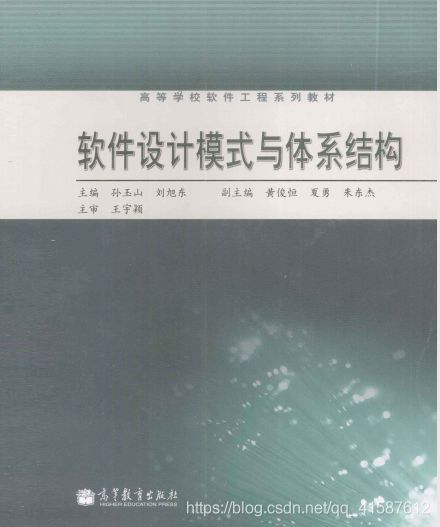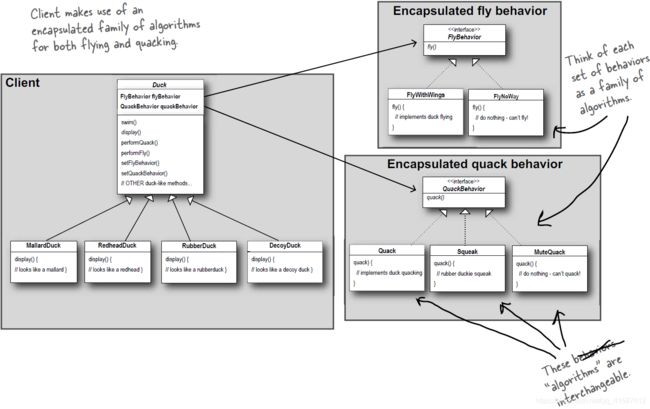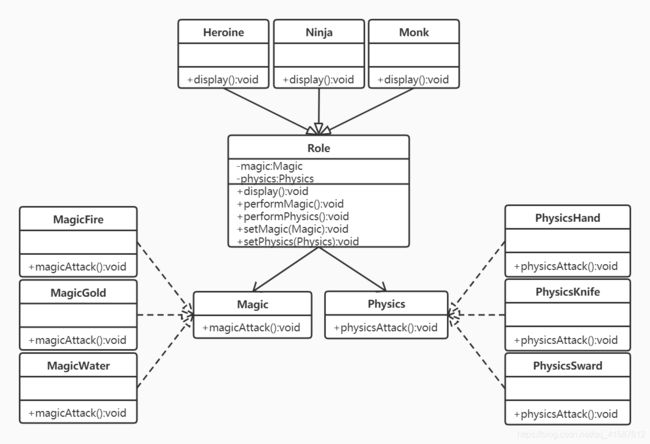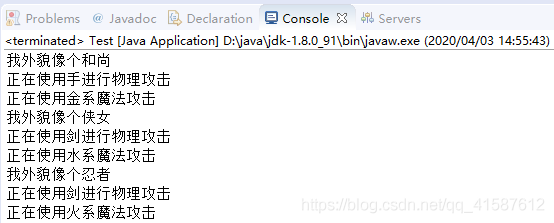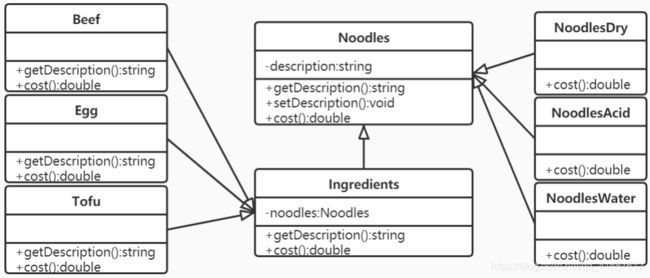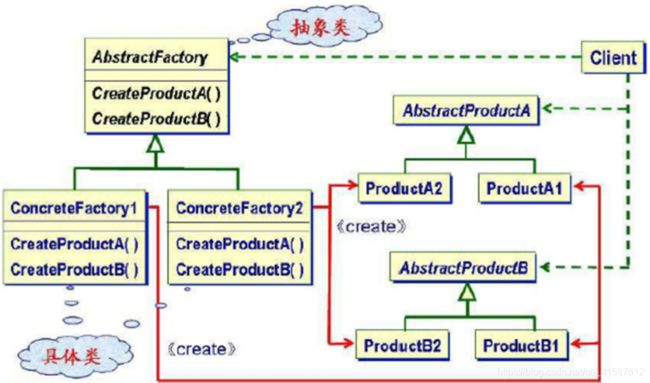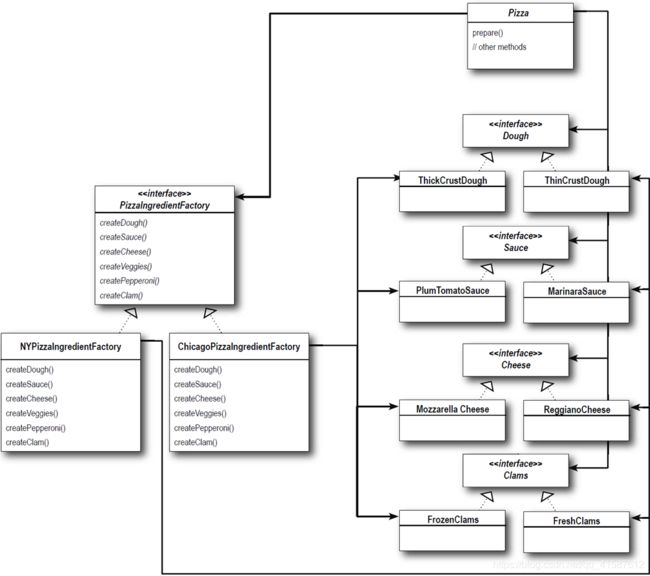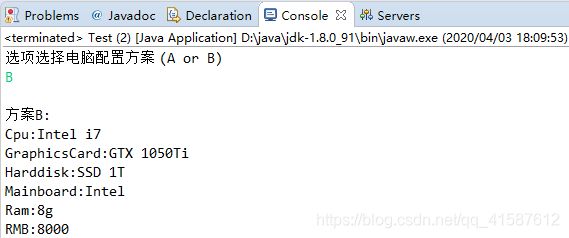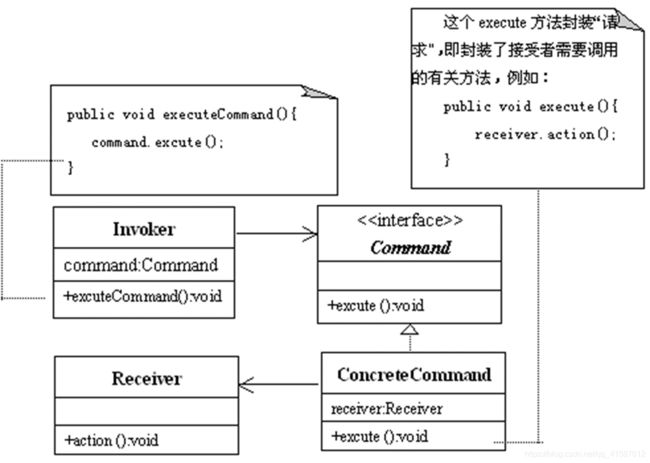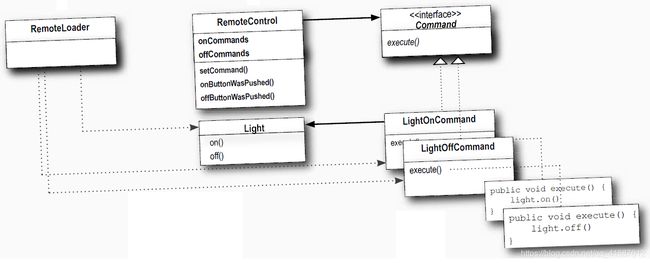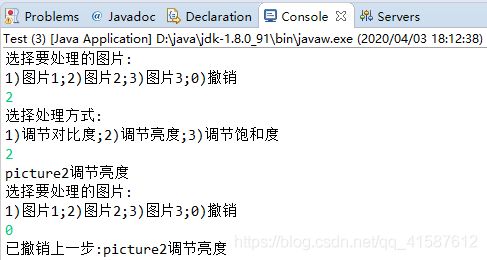软件设计模式与体系结构【实验报告合集】
四个实验(两学时):策略模式、装饰者模式、抽象工厂模式、命令模式【没做GUI界面,只满足最简要求】
本文对你有用的话,记得点赞哦!以下是教科书&参考书
策略模式 Strategy Pattern
策略模式定义了算法族,分别封装起来,让他们之间可以互相替换,此模式让算法的变化独立于使用算法的客户。在熟悉策略模式相关理论知识的基础上,使用策略模式实现一个小游戏。
一、基本要求
使用策略模式实现一个小游戏,要求如下:
- 游戏中有三个角色:和尚,侠女,忍者;
- 每个角色都有生命值和魔法值,但各角色不同。
- 各角色外观不同。
- 每个角色具有魔法攻击和物理攻击;
- 物理攻击有三种:用刀、用剑、用手;
- 魔法攻击也有三种:火系魔法、金系魔法、水系魔法;
各角色可以动态更换物理、魔法攻击方式,也可以动态选择攻击方法。
笔者推荐参考https://blog.csdn.net/qq_42685588/article/details/103576562
二、实验内容
1. 设计并绘制该程序的类图;
2. 依照设计的类图使用Java语言编写代码,并实现该程序;
3. 除了核心的模式相关类实现外,提供测试环境,按照难度高低,分别是:
a)控制台程序,Client硬编码初始化模式和测试环境,运行结果文本输出;
b)控制台程序,Client初始化测试环境,并根据用户输入运算,运行结果文本输出;
c)设计并实现用户UI,Client初始化测试环境,并根据用户在UI控件上的输入运算,运行结果文本输出;
三、实验提示
1. 策略模式的结构和组件
- Strategy:定义所有支持算法的公共接口,Context使用该接口调用某ConcreteStrategy定义的算法;
- ConcreteStrategy:以Strategy接口实现某具体算法;
- Context:用一个ConcreteStrategy对象来配置,维护一个对Strategy对象的引用,可定义一个接口来让Strategy访问它的数据;
2. 策略模式代码提示 【出自《Head First设计模式》一书】
SimUDuck范例:将duck的行为理解为 “一组行为”,并使用策略模式的“一族算法”来进行实现。
Duck基类
public abstract class Duck {
FlyBehavior flyBehavior;
QuackBehavior quackBehavior;
public Duck() {
}
public void setFlyBehavior (FlyBehavior fb) {
flyBehavior = fb;
}
public void setQuackBehavior(QuackBehavior qb) {
quackBehavior = qb;
}
abstract void display();
public void performFly() {
flyBehavior.fly();
}
public void performQuack() {
quackBehavior.quack();
}
public void swim() {
System.out.println("All ducks float, even decoys!");
}
}FlyBehavior和QuackBehavior接口
public interface QuackBehavior {
public void quack();
}
public interface FlyBehavior {
public void fly();
}FlyWithWings具体行为
public class FlyWithWings implements FlyBehavior {
public void fly() {
System.out.println("I'm flying!!");
}
}MiniDuckSimulator测试环境
public class MiniDuckSimulator {
public static void main(String[] args) {
MallardDuck mallard = new MallardDuck();
RubberDuck rubberDuckie = new RubberDuck();
DecoyDuck decoy = new DecoyDuck();
ModelDuck model = new ModelDuck();
mallard.performQuack();
rubberDuckie.performQuack();
decoy.performQuack();
model.performFly();
model.setFlyBehavior(new FlyRocketPowered());
model.performFly();
}
}
四、实验原理(算法或图)
图1 策略模式类图
五、源代码
Role(基类)
public abstract class Role {
Magic magic;
Physics physics;
public Role(Magic magic, Physics physics) {
setMagic(magic);
setPhysics(physics);
};
public abstract void display();
public void performMagic() {
magic.magicAttack();
}
public void performPhysics() {
physics.physicsAttack();
}
public void setMagic(Magic magic) {
this.magic = magic;
}
public void setPhysics(Physics physics) {
this.physics = physics;
}
}Monk和尚、Heroine侠女、Ninja忍者(子类)
public class Monk extends Role {
public Monk(Magic magic, Physics physics) {
super(magic, physics);
}
@Override
public void display() {
System.out.println("我外貌像个和尚");
}
}
public class Heroine extends Role {
public Heroine(Magic magic, Physics physics) {
super(magic, physics);
}
@Override
public void display() {
System.out.println("我外貌像个侠女");
}
}
public class Ninja extends Role {
public Ninja(Magic magic, Physics physics) {
super(magic, physics);
}
@Override
public void display() {
System.out.println("我外貌像个忍者");
}
}Magic接口
public interface Magic {
public void magicAttack() ;
}实现Magic的类
public class MagicFire implements Magic {
@Override
public void magicAttack() {
System.out.println("正在使用火系魔法攻击");
}
}
public class MagicGold implements Magic {
@Override
public void magicAttack() {
System.out.println("正在使用金系魔法攻击");
}
}
public class MagicWater implements Magic {
@Override
public void magicAttack() {
System.out.println("正在使用水系魔法攻击");
}
}Physics接口
public interface Physics {
public void physicsAttack() ;
}实现Physics的类
public class PhysicsHand implements Physics {
@Override
public void physicsAttack() {
System.out.println("正在使用手进行物理攻击");
}
}
public class PhysicsKnife implements Physics {
@Override
public void physicsAttack() {
System.out.println("正在使用刀进行物理攻击");
}
}
public class PhysicsSword implements Physics {
@Override
public void physicsAttack() {
System.out.println("正在使用剑进行物理攻击");
}
}Test类
public class Test {
public static void main(String[] args) {
Monk monk = new Monk(new MagicGold(), new PhysicsHand());
monk.display();
monk.performPhysics();
monk.performMagic();
Heroine heroine =new Heroine(new MagicWater(), new PhysicsSword());
heroine.display();
heroine.performPhysics();
heroine.performMagic();
Ninja ninja = new Ninja(new MagicFire(), new PhysicsSword());
ninja.display();
ninja.performPhysics();
ninja.performMagic();
}
}六、运行结果
装饰者模式 Decorator Pattern
装饰者模式动态地将责任附加到对象上,若要扩展功能,装饰者提供了比继承更有弹性的替代方案。在熟悉装饰者模式相关理论知识的基础上,使用装设者模式实现米线店结账小程序。
一、基本要求
使用装饰者模式实现米线店结账程序,要求如下:
- 米线有三种,干浆、酸浆和水米线。
- 配料有三种,豆腐、鸡蛋、牛肉,今后还会更多。
- 客户可疑随心所欲的要各种米线搭配各种配料,配料可以加同一种加多份,或者不同种加多份。
二、实验内容
1. 设计并绘制该程序的类图;
2. 依照设计的类图使用Java语言编写代码,并实现该程序;
3. 除了核心的模式相关类实现外,提供测试环境,按照难度高低,分别是:
a)控制台程序,Client硬编码初始化模式和测试环境,运行结果文本输出;
b)控制台程序,Client初始化测试环境,并根据用户输入运算,运行结果文本输出;
c)设计并实现用户UI,Client初始化测试环境,并根据用户在UI控件上的输入运算,运行结果文本输出;
三、实验提示
1. 装饰者模式的结构和组件
- Component:对象接口,可以给对象动态地添加职责;
- Concrete Component:具体对象;
- Decorator:维持一个指向Component对象的指针,并定义一个与Component接口一致的接口;
- ConcreteDecorator:向组件添加职责;
- Decorator将请求转发给它的Component对象,并有可能在转发请求前后执行一些附加的动作;
2. 装饰者模式代码提示
Starbuzz范例:以饮料为主体,然后在运行时以调料来“装饰”饮料。
Beverage 基类
public abstract class Beverage {
String description = "Unknown Beverage";
public String getDescription() {
return description;
}
public abstract double cost();
}HouseBlend 具体饮料类
public class HouseBlend extends Beverage {
public HouseBlend() {
description = "House Blend Coffee";
}
public double cost() {
return .89;
}
}CondimentDecorator 调料基类
public abstract class CondimentDecorator extends Beverage {
public abstract String getDescription();
}Soy 具体调料类
public class Soy extends CondimentDecorator {
Beverage beverage;
public Soy(Beverage beverage) {
this.beverage = beverage;
}
public String getDescription() {
return beverage.getDescription() + ", Soy";
}
public double cost() {
return .15 + beverage.cost();
}
}StarbuzzCoffee 测试环境
public class StarbuzzCoffee {
public static void main(String args[]) {
Beverage beverage = new Espresso();
System.out.println(beverage.getDescription() + " $" + beverage.cost());
Beverage beverage2 = new DarkRoast();
beverage2 = new Mocha(beverage2);
beverage2 = new Mocha(beverage2);
beverage2 = new Whip(beverage2);
System.out.println(beverage2.getDescription() + " $" + beverage2.cost());
Beverage beverage3 = new HouseBlend();
beverage3 = new Soy(beverage3);
beverage3 = new Mocha(beverage3);
beverage3 = new Whip(beverage3);
System.out.println(beverage3.getDescription() + " $" + beverage3.cost());
}
}四、实验原理(算法或图)
五、源码
Noodles基类
public abstract class Noodles {
private String description = null;
public String getDescription() {
return description;
}
public void setDescription(String description) {
this.description = description;
}
public abstract double cost();
}继承Noodles的类
public class NoodlesAcid extends Noodles {
public NoodlesAcid() {
String description="酸浆米线";
setDescription(description);
}
@Override
public double cost() {
return 3;
}
}
public class NoodlesDry extends Noodles {
public NoodlesDry() {
String description="干浆米线";
setDescription(description);
}
@Override
public double cost() {
return 2;
}
}
public class NoodlesWater extends Noodles {
public NoodlesWater() {
String description="水米线";
setDescription(description);
}
@Override
public double cost() {
return 2;
}
}Ingredients基类
public abstract class Ingredients extends Noodles {
public abstract String getDescription();
@Override
public double cost() {
return 0;
}
}继承Ingredients的类
public class Beef extends Ingredients{
private Noodles noodles=null;
public Beef(Noodles noodles){
this.noodles = noodles;
}
@Override
public String getDescription() {
String str = noodles.getDescription();
if(str.indexOf("牛肉") != -1){
return str;
}else{
return "牛肉" + noodles.getDescription();
}
}
public double cost(){
return 5 + noodles.cost();
}
}
public class Egg extends Ingredients {
private Noodles noodles=null;
public Egg(Noodles noodles){
this.noodles = noodles;
}
@Override
public String getDescription() {
String str = noodles.getDescription();
if(str.indexOf("鸡蛋") != -1){
return str;
}else{
return "鸡蛋" + noodles.getDescription();
}
}
public double cost(){
return 2 + noodles.cost();
}
}
public class Tofu extends Ingredients{
private Noodles noodles=null;
public Tofu(Noodles noodles){
this.noodles = noodles;
}
@Override
public String getDescription() {
String str = noodles.getDescription();
if(str.indexOf("豆腐") != -1){
return str;
}else{
return "豆腐" + noodles.getDescription();
}
}
public double cost(){
return 2.5 + noodles.cost();
}
}Test类
public class Test {
public static void main(String[] args) {
Noodles noodles1 = new NoodlesDry();
noodles1 = new Egg(noodles1);
noodles1 = new Beef(noodles1);
System.out.println(noodles1.getDescription() + noodles1.cost());
Noodles noodles2 = new NoodlesAcid();
noodles2 = new Tofu(noodles2);
noodles2 = new Beef(noodles2);
System.out.println(noodles2.getDescription() + noodles2.cost());
}
}六、实验结果
抽象工厂模式 Abstract Factory Pattern
抽象工厂模式提供一个接口,用于创建相关或依赖对象的家族,而不需要明确指定具体类。在熟悉抽象工厂模式相关理论知识的基础上,使用抽象工厂模式实现“电脑配置商店”程序。
一、基本要求
使用抽象工厂模式实现“电脑配置商店”,要求如下:
- 电脑由CPU、主板、显卡、内存、硬盘等配件组合而成。现电脑配置有两种配置方案。
- 根据配置方案可以显示具体配置信息。
- 根据配置方案可以显示价格。
二、实验内容
1. 设计并绘制该程序的类图;
2. 依照设计的类图使用Java语言编写代码,并实现该程序;
3. 除了核心的模式相关类实现外,提供测试环境,按照难度高低,分别是:
a)控制台程序,Client硬编码初始化模式和测试环境,运行结果文本输出;
b)控制台程序,Client初始化测试环境,并根据用户输入运算,运行结果文本输出;
c)设计并实现用户UI,Client初始化测试环境,并根据用户在UI控件上的输入运算,运行结果文本输出;
三、实验提示
1. 抽象工厂模式的结构和组件
- Abstract Factory:声明创建抽象产品对象的操作接口;
- ConcreteFactory:实现创建具体对象的操作;
- Abstract Product:为一类产品对象声明一个接口;
- ConcreteProduct:定义一个被具体工厂创建的产品对象;
2. 抽象工厂模式代码提示
PizzaStore范例:抽象工厂允许客户使用抽象的接口来创建一组相关的产品,而不需要知道实际产出的具体产品是什么,这样一来,客户就从具体的产品中被解耦。
PizzaIngredientFactory 接口
public interface PizzaIngredientFactory {
public Dough createDough();
public Sauce createSauce();
public Cheese createCheese();
public Veggies[] createVeggies();
public Pepperoni createPepperoni();
public Clams createClam();
}ChicagoPizzaIngredientFactory 具体实现类
public class ChicagoPizzaIngredientFactory
implements PizzaIngredientFactory
{
public Dough createDough() {
return new ThickCrustDough();
}
public Sauce createSauce() {
return new PlumTomatoSauce();
}
public Cheese createCheese() {
return new MozzarellaCheese();
}
public Veggies[] createVeggies() {
Veggies veggies[] = { new BlackOlives(),
new Spinach(),
new Eggplant() };
return veggies;
}
public Pepperoni createPepperoni() {
return new SlicedPepperoni();
}
public Clams createClam() {
return new FrozenClams();
}
}Pizza 基类
public abstract class Pizza {
String name;
Dough dough;
Sauce sauce;
Veggies veggies[];
Cheese cheese;
Pepperoni pepperoni;
Clams clam;
abstract void prepare();
void bake() {
System.out.println("Bake for 25 minutes at 350");
}
void cut() {
System.out.println("Cutting the pizza into diagonal slices");
}
void box() {
System.out.println("Place pizza in official PizzaStore box");
}
void setName(String name) {
this.name = name;
}
String getName() {
return name;
}
public String toString() {
StringBuffer result = new StringBuffer();
result.append("---- " + name + " ----\n");
if (dough != null) {
result.append(dough);
result.append("\n");
}
if (sauce != null) {
result.append(sauce);
result.append("\n");
}
if (cheese != null) {
result.append(cheese);
result.append("\n");
}
if (veggies != null) {
for (int i = 0; i < veggies.length; i++) {
result.append(veggies[i]);
if (i < veggies.length-1) {
result.append(", ");
}
}
result.append("\n");
}
if (clam != null) {
result.append(clam);
result.append("\n");
}
if (pepperoni != null) {
result.append(pepperoni);
result.append("\n");
}
return result.toString();
}
}Dough 接口及实现
public interface Dough {
public String toString();
}
public class ThickCrustDough implements Dough {
public String toString() {
return "ThickCrust style extra thick crust dough";
}
}PizzaTestDrive 测试环境
public class PizzaTestDrive {
public static void main(String[] args) {
PizzaStore nyStore = new NYPizzaStore();
PizzaStore chicagoStore = new ChicagoPizzaStore();
Pizza pizza = nyStore.orderPizza("cheese");
System.out.println("Ethan ordered a " + pizza + "\n");
pizza = chicagoStore.orderPizza("cheese");
System.out.println("Joel ordered a " + pizza + "\n");
pizza = nyStore.orderPizza("clam");
System.out.println("Ethan ordered a " + pizza + "\n");
pizza = chicagoStore.orderPizza("clam");
System.out.println("Joel ordered a " + pizza + "\n");
pizza = nyStore.orderPizza("pepperoni");
System.out.println("Ethan ordered a " + pizza + "\n");
pizza = chicagoStore.orderPizza("pepperoni");
System.out.println("Joel ordered a " + pizza + "\n");
pizza = nyStore.orderPizza("veggie");
System.out.println("Ethan ordered a " + pizza + "\n");
pizza = chicagoStore.orderPizza("veggie");
System.out.println("Joel ordered a " + pizza + "\n");
}
}四、实验原理
五、源码
ComputerStore类
public abstract class ComputerStore {
ComputerFactory computer;
public abstract ComputerFactory createComputer(String type) ;
}继承ComputerStore的类
public class Computer extends ComputerStore{
public ComputerFactory createComputer(String type){
ComputerFactory computer=null;
if(type.equals("A")){
computer=new AFactory();
}
else if(type.equals("B")){
computer=new BFactory();
}
computer.createCpu();
computer.createGraphicsCard();
computer.createHarddisk();
computer.createMainboard();
computer.createRam();
computer.displayPrice();
return computer;
}
}ComputerFactory接口
public interface ComputerFactory {
public Cpu createCpu();
public Mainboard createMainboard();
public GraphicsCard createGraphicsCard();
public Ram createRam();
public Harddisk createHarddisk();
public void displayPrice();
}实现ComputerFactory的类
public class AFactory implements ComputerFactory{
public AFactory(){
System.out.println("\n方案A:");
}
public Cpu createCpu() {
return new ACpu();
}
public Mainboard createMainboard() {
return new AMainboard();
}
public GraphicsCard createGraphicsCard() {
return new AGraphicsCard();
}
public Ram createRam() {
return new ARam();
}
public Harddisk createHarddisk() {
return new AHarddisk();
}
public void displayPrice() {
System.out.println("RMB:4000");
}
}
public class BFactory implements ComputerFactory{
public BFactory(){
System.out.println("\n方案B:");
}
public Cpu createCpu() {
return new BCpu();
}
public Mainboard createMainboard() {
return new BMainboard();
}
public GraphicsCard createGraphicsCard() {
return new BGraphicsCard();
}
public Ram createRam() {
return new BRam();
}
public Harddisk createHarddisk() {
return new BHarddisk();
}
public void displayPrice() {
System.out.println("RMB:8000");
}
}Cpu接口
public interface Cpu {
String Cpu=new String();
}实现Cpu的类
public class ACpu implements Cpu {
String Cpu = new String();
public ACpu(){
Cpu="Intel i5";
System.out.println("Cpu:" + Cpu);
}
}
public class BCpu implements Cpu {
String Cpu = new String();
public BCpu(){
Cpu="Intel i7";
System.out.println("Cpu:" + Cpu);
}
}GraphicsCard接口
public interface GraphicsCard {
String GraphicsCard=new String();
}实现GraphicsCard的类
public class AGraphicsCard implements GraphicsCard{
String GraphicsCard=new String();
public AGraphicsCard(){
GraphicsCard="GTX 1050";
System.out.println("GraphicsCard:"+GraphicsCard);
}
}
public class BGraphicsCard implements GraphicsCard{
String GraphicsCard = new String();
public BGraphicsCard(){
GraphicsCard="GTX 1050Ti";
System.out.println("GraphicsCard:"+GraphicsCard);
}
}Harddisk接口
public interface Harddisk {
String Harddisk=new String();
}实现Harddisk的类
public class AHarddisk implements Harddisk{
String Harddisk=new String();
public AHarddisk(){
Harddisk="HDD 1T";
System.out.println("Harddisk:"+Harddisk);
}
}
public class BHarddisk implements Harddisk {
String Harddisk=new String();
public BHarddisk(){
Harddisk="SSD 1T";
System.out.println("Harddisk:"+Harddisk);
}
}Mianboard接口
public interface Mainboard {
String Mainboard=new String();
}继承Mianboard的类
public class AMainboard implements Mainboard{
String Mainboard=new String();
public AMainboard(){
Mainboard="ASUS";
System.out.println("Mainboard:"+Mainboard);
}
}
public class BGraphicsCard implements GraphicsCard{
String GraphicsCard = new String();
public BGraphicsCard(){
GraphicsCard="GTX 1050Ti";
System.out.println("GraphicsCard:"+GraphicsCard);
}
}Ram接口
public interface Ram {
String Ram =new String();
}实现Ram的类
public class ARam implements Ram{
String Ram=new String();
public ARam(){
Ram="4g";
System.out.println("Ram:"+Ram);
}
}
public class BRam implements Ram{
String Ram=new String();
public BRam(){
Ram="8g";
System.out.println("Ram:"+Ram);
}
}Test类
import java.util.Scanner;
public class Test {
public static void main(String[] args) {
Computer computer=new Computer ();
Scanner sc = new Scanner(System.in);
System.out.println("选项选择电脑配置方案 (A or B)");
String k = sc.nextLine();
sc.close();
switch(k){
case "A": case "a":
computer.createComputer("A");
break;
case "B": case "b":
computer.createComputer("B");
break;
default:
System.out.println("不存在所选择方案");
break;
}
}
}
六、实验结果
命令模式 Command Pattern
命令模式将“请求”封装成对象,以便使用不同的请求、队列或者日志来参数化其他对象,命令模式也支持可撤销的操作。在熟悉命令模式相关理论知识的基础上,使用命令模式实现图片处理程序。
一、基本要求
使用命令模式实现图片处理程序,要求如下:
- 图片处理程序要有3张图片。
- 每张图片至少有3种操作。
- 实现类似遥控器的菜单,动态的选择对图片进行的处理。
- 要有“撤消操作”,撤消操作要可以撤销至最后一步。
二、 实验内容
1. 设计并绘制该程序的类图;
2. 依照设计的类图使用Java语言编写代码,并实现该程序;
3. 除了核心的模式相关类实现外,提供测试环境,按照难度高低,分别是:
a)控制台程序,Client硬编码初始化模式和测试环境,运行结果文本输出;
b)控制台程序,Client初始化测试环境,并根据用户输入运算,运行结果文本输出;
c)设计并实现用户UI,Client初始化测试环境,并根据用户在UI控件上的输入运算,运行结果文本输出;
三、实验提示
1. 命令模式的结构和组件
- Command:声明执行操作的接口;
- ConcreteCommand:将一个接收者对象绑定于一个动作,调用接收者相应的操作;
- Client(Application):创建一个具体命令对象并设定其接收者;
- Invoker(MenuItem):要求命令执行请求;
- Receiver(Document,Application):知道如何实施与执行一个请求相关的操作;
2. 命令模式代码提示
RemoteControl范例:命令对象将动作和接收者包进对象中。这个对象只暴露出一个execute()方法,当此方法调用的时候,接收者就会进行这些动作。
RemoteControl类
public class RemoteControl {
Command[] onCommands;
Command[] offCommands;
public RemoteControl() {
onCommands = new Command[7];
offCommands = new Command[7];
Command noCommand = new NoCommand();
for (int i = 0; i < 7; i++) {
onCommands[i] = noCommand;
offCommands[i] = noCommand;
}
}
public void setCommand(int slot, Command onCommand, Command offCommand) {
onCommands[slot] = onCommand;
offCommands[slot] = offCommand;
}
public void onButtonWasPushed(int slot) {
onCommands[slot].execute();
}
public void offButtonWasPushed(int slot) {
offCommands[slot].execute();
}
public String toString() {
StringBuffer stringBuff = new StringBuffer();
stringBuff.append("\n------ Remote Control -------\n");
for (int i = 0; i < onCommands.length; i++) {
stringBuff.append("[slot " + i + "] " + onCommands[i].getClass().getName()
+ " " + offCommands[i].getClass().getName() + "\n");
}
return stringBuff.toString();
}
}Command类
public interface Command {
public void execute();
}Light类
public class Light {
String location = "";
public Light(String location) {
this.location = location;
}
public void on() {
System.out.println(location + " light is on");
}
public void off() {
System.out.println(location + " light is off");
}
}LightOnCommand类
public class LightOnCommand implements Command {
Light light;
public LightOnCommand(Light light) {
this.light = light;
}
public void execute() {
light.on();
}
}测试环境RemoteLoader
public class RemoteLoader {
public static void main(String[] args) {
RemoteControl remoteControl = new RemoteControl();
Light livingRoomLight = new Light("Living Room");
Light kitchenLight = new Light("Kitchen");
CeilingFan ceilingFan= new CeilingFan("Living Room");
GarageDoor garageDoor = new GarageDoor("");
Stereo stereo = new Stereo("Living Room");
LightOnCommand livingRoomLightOn =
new LightOnCommand(livingRoomLight);
LightOffCommand livingRoomLightOff =
new LightOffCommand(livingRoomLight);
LightOnCommand kitchenLightOn =
new LightOnCommand(kitchenLight);
LightOffCommand kitchenLightOff =
new LightOffCommand(kitchenLight);
CeilingFanOnCommand ceilingFanOn =
new CeilingFanOnCommand(ceilingFan);
CeilingFanOffCommand ceilingFanOff =
new CeilingFanOffCommand(ceilingFan);
GarageDoorUpCommand garageDoorUp =
new GarageDoorUpCommand(garageDoor);
GarageDoorDownCommand garageDoorDown =
new GarageDoorDownCommand(garageDoor);
StereoOnWithCDCommand stereoOnWithCD =
new StereoOnWithCDCommand(stereo);
StereoOffCommand stereoOff =
new StereoOffCommand(stereo);
remoteControl.setCommand(0, livingRoomLightOn, livingRoomLightOff);
remoteControl.setCommand(1, kitchenLightOn, kitchenLightOff);
remoteControl.setCommand(2, ceilingFanOn, ceilingFanOff);
remoteControl.setCommand(3, stereoOnWithCD, stereoOff);
System.out.println(remoteControl);
remoteControl.onButtonWasPushed(0);
remoteControl.offButtonWasPushed(0);
remoteControl.onButtonWasPushed(1);
remoteControl.offButtonWasPushed(1);
remoteControl.onButtonWasPushed(2);
remoteControl.offButtonWasPushed(2);
remoteControl.onButtonWasPushed(3);
remoteControl.offButtonWasPushed(3);
}
}四、实验原理
五、源码
图片类
public class Picture1 {
public String rotate(){
return "Picture1旋转";
}
public String cut(){
return "Picture1剪切";
}
public String mirror(){
return "Picture1镜像";
}
}
public class Picture2 {
public String adjustContrast(){
return "picture2调节对比度";
}
public String adjustBrightness(){
return "picture2调节亮度";
}
public String adjustSaturation(){
return "picture2调节饱和度";
}
}
public class Picture3 {
public String zoomIn(){
return "Picture3放大";
}
public String zoomOut(){
return "Picture3缩小";
}
public String warping(){
return "Picture3扭曲";
}
}Command接口
public interface Command {
public String execute();
}实现Command的类
public class CommandCut implements Command {
Picture1 picture = null;
public CommandCut(Picture1 picture){
this.picture = picture;
}
@Override
public String execute() {
return picture.cut();
}
}
public class CommandMirror implements Command {
Picture1 picture = null;
public CommandMirror(Picture1 picture){
this.picture = picture;
}
@Override
public String execute() {
return picture.mirror();
}
}
public class CommandRotate implements Command {
Picture1 picture = null;
public CommandRotate(Picture1 picture){
this.picture = picture;
}
@Override
public String execute() {
return picture.rotate();
}
}
public class CommandWarping implements Command {
Picture3 picture = null;
public CommandWarping(Picture3 picture){
this.picture = picture;
}
@Override
public String execute() {
return picture.warping();
}
}
public class CommandZoomIn implements Command {
Picture3 picture = null;
public CommandZoomIn(Picture3 picture){
this.picture = picture;
}
@Override
public String execute() {
return picture.zoomIn();
}
}
public class CommandZoomOut implements Command {
Picture3 picture = null;
public CommandZoomOut(Picture3 picture){
this.picture = picture;
}
@Override
public String execute() {
return picture.zoomOut();
}
}
public class CommandNo implements Command{
@Override
public String execute() {
return null;
}
}
public class CommandRevoke implements Command {
Command command = null;
public CommandRevoke(Command command){
this.command = command;
}
@Override
public String execute() {
return "已撤销上一步:" + command.execute();
}
}Test类
public class Test {
public static void main(String[] args) {
Scanner sc = new Scanner(System.in);
Command command = null;
while(true) {
System.out.println("选择要处理的图片:\n1)图片1;2)图片2;3)图片3;0)撤销");
String k = sc.nextLine();
switch(k) {
case "1":
Picture1 picture1 = new Picture1();
System.out.println("选择处理方式:\n1)旋转;2)剪切;3)镜像");
String key1 = sc.nextLine();
switch(key1) {
case "1": command = new CommandRotate(picture1); break;
case "2": command = new CommandCut(picture1); break;
case "3": command = new CommandMirror(picture1); break;
default: command = new CommandNo(); break;
}
break;
case "2":
Picture2 picture2 = new Picture2();
System.out.println("选择处理方式:\n1)调节对比度;2)调节亮度;3)调节饱和度");
String key2 = sc.nextLine();
switch(key2) {
case "1": command = new CommandAdjustContrast(picture2); break;
case "2": command = new CommandAdjustBrightness(picture2); break;
case "3": command = new CommandAdjustSaturation(picture2); break;
default: command = new CommandNo(); break;
}
break;
case "3":
Picture3 picture3 = new Picture3();
System.out.println("选择处理方式:\n1)放大;2)缩小;3)扭曲");
String key3 = sc.nextLine();
switch(key3) {
case "1": command = new CommandZoomIn(picture3); break;
case "2": command = new CommandZoomOut(picture3); break;
case "3": command = new CommandWarping(picture3); break;
default: command = new CommandNo(); break;
}
break;
case "0":
command = new CommandRevoke(command);
break;
}
System.out.println(command.execute());
}
}
}六、实验结果
